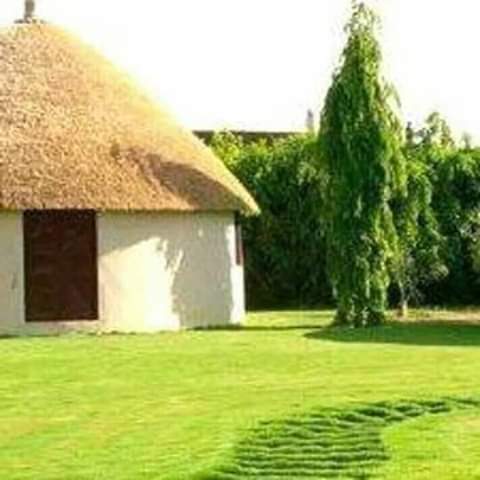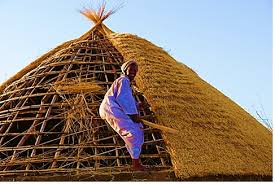Sudan’s Straw Hut (The Guttiyya): Cool In Summer, Warm In Winter
04 August, 2019
KHARTOUM (Sudanow) - With its conical shape, the Sudanese straw hut (guttiyya in Sudanese Arabic), is one of the important symbols of ancient Sudanese architecture that still resist the spread of modernity.
Because of its ability to resist heavy rain, the British colonialists have copied its structure in the construction of railway personnel homes, a practice that still exists in today’s Sudan.
The straw hut is built in many of the Sudanese villages and on the outskirts of urban areas. But the districts of Gedarif (East), the Blue Nile (South East), Kordofan (Midwest) and Darfur (far West) have the greatest passion for building straw huts, largely because of their heavy rainfall and the availability of materials (simply timber and straw) needed for building such homes in those regions.

To have a better look at this architectural art, Sudanow has toured some of those districts:
Darfur
Mohammad Ahmed Mansour Alshayib, a researcher in Darfur and Sudan’s cultural heritage, says the straw hut is conic at the top and circular at the bottom. It is constructed entirely from local substances. At the beginning, a circular structure is constructed using tree branches. These branches are tied together with ropes obtained from tree bark or palm leaves. This circular ring is  the base of the structure on which four strong poles stand and is called ‘the kajja’. These poles are then supported by smaller poles called the ‘miroog’. Heads of these poles converge at the top and are tied tightly. Here the hut shapes out in a conic or tomb-like structure. The skeleton thus obtained is covered with straw.
the base of the structure on which four strong poles stand and is called ‘the kajja’. These poles are then supported by smaller poles called the ‘miroog’. Heads of these poles converge at the top and are tied tightly. Here the hut shapes out in a conic or tomb-like structure. The skeleton thus obtained is covered with straw.
The Darfur huts are not always the same. In the mountainous Jebel Marra district, known for its heavy rains, the hut roof is made of straw while the perimeter is built from stone and takes a special characteristic that keeps humidity in the summer and warmth in the winter. In Darfur’s plains and valleys hut bodies are covered entirely with millet straw, known for its resilience. The millet straw is woven by ropes and tree bark. In some cases the hut is roofed by maharaib stalks abundant in such areas. The maharaib herb is known for its health benefits (soothes renal and stomach disorders) and for the pleasant smell it emits during rainfall. This plant is also known for conserving humidity that keeps the place cool.
Another type known as dahar altour (the ox back) is built by the well-to-do and tribal  chieftains. It has a diameter of 4-6 meters and its perimeter is built from clay. Here the perimeter is tied to the upper structure with a beam of sesbania and phragmites branches. It is woven by tamarind and maharaib roots to give a nice smell. This hut, also known as ‘durdur’ and is reserved for house guests, thanks for its nice atmosphere and its wide space, whereas the area of the ordinary hut does not exceed 2-3 meters. Doors are made of tin, timber or strong stalks and open opposite to the sun’s afternoon direction.
chieftains. It has a diameter of 4-6 meters and its perimeter is built from clay. Here the perimeter is tied to the upper structure with a beam of sesbania and phragmites branches. It is woven by tamarind and maharaib roots to give a nice smell. This hut, also known as ‘durdur’ and is reserved for house guests, thanks for its nice atmosphere and its wide space, whereas the area of the ordinary hut does not exceed 2-3 meters. Doors are made of tin, timber or strong stalks and open opposite to the sun’s afternoon direction.
According to Mr. Shayib, the Darfuri guttiyya is part of the Darfuri heritage and is still built despite the turn to modern architecture, because of the air of tranquility it gives.
A single Darfuri hut can resist weather conditions for 30 years given frequent repairing of its ropes and straw. Any change in these huts materials, like building them from cement, will cause them to lose their characteristic of being cool in the summer and warm in winter.
The straw huts can make an integrated home as can be seen in the Sultan Ali Dinar Museum in Alfashir that contains a semblance of a guest room attached with it a durdur (guest reception hall) and a sleeping room and a tukul (traditional kitchen) where food is cooked.


Kordofan
In the Kordofan region, engineer Hassan Dagoug Azrag said straw huts are everywhere, in the villages and in the towns. The straw huts in this region differ in shape and size, according to need and according to the materials used. We can find round and square huts. All its parts can be built from straw.
The Kordofan straw hut is strong and is characterized with coloration and embroidery. Some skillful technicians are noted for building such huts in terms of space and size. The locals also build them through self-help (what is known as nafeer in the Sudanese culture). In this the youths work collectively to repair old huts or build new ones. This occurs before the rainy season. The group builds or repairs the huts using natural substances available around them. Thus made, the Kordofan straw hut is hygienic and environment friendly. It is cool in the summer and warm in winter. Some city dwellers attach them to their homes or build them on their rooftops for afternoon siesta, in particular for elders. They also give the home a nice-looking shape. Highway cafeterias also build them to attract customers and tourists, in particular for their appealing conic shapes which are believed to have fascinated British rulers of Sudan so they replicated them in building railway houses and some school boarding houses.
Researcher Azrag asserts that the straw hut still maintains its position in villages and agricultural zones as the required building materials are abundant in those places.
Families usually start with one hut at wedding. The matrimony hut is usually painted in bright colors and geometric embroideries. Beside this hut they build a rakoba (shack) from timber poles. They roof it with straw mats and empty jute sacks. The family then builds more huts as more children come forth. In a single home one can find more than five huts according to the family size. In the one home we can find a hut for kids, another for guests, another as a store, one for keeping young livestock and one for cooking.
According to engineer Azrag, when a senior girl in the Kordofani family gets married, the bride’s mother asks the groom to build his own hut inside the bride’s home. He lives with his wife in this hut until when the new couple build their own home. The hut thus built is then added to the bride’s existing family home.
The Blue Nile
Heritage Researcher Ali Mukhtar Omar considers the straw hut a component of the Blue Nile District’s heritage. It is an incarnation of a set of meanings and values and represents a natural scenery of the Blue Nile civilization. Despite the progress in house building, the straw hut has maintained its position in the conscience of all Sudanese. The straw hut is part of the house formations in the Blue Nile and forms a setting that fits the nature and economy of the region. It protects the inhabitants from the heat of the sun in summer and during the rainy season. It quickly drains the water down to the ground, thus preventing any inundation.
Like what happens in Kordofan, inhabitants gather together to build new huts or repair existing ones. The owner of a projected hut invites his relatives and friends to give a hand. Women prepare food. After the job is done, the group gathers together for singing and dancing, a matter that boosts social relations a good deal. Like in other places the straw hut in the Blue Nile is built from tree branches and trunks and straw.
Gedarif
One of the notables of Gedarif District, Taj Alsir Mohammad Ahmed considers the straw hut an ancient heritage of Sudanese, in fact the first home dwelt by Sudanese. It used to be built from tree branches and trunks and covered with straw. Like in other places in Sudan, the Gedarif straw hut is conic in shape. But now the circular lower part is built with clay or bricks. Gedarif straw huts now enjoy running water, electricity and even air coolers and is colored and embroidered from within. Though the option for straw huts in the town is diminishing as the living conditions improve and as the winds of change continue to blow, straw huts in Gedarif rural areas are still used. They can stand the heavy rains and the expansive clay soil of that region. That is why they are the most suitable homes for the people of that region.
The Straw Hut In Sudanese Art
The straw hut is very conspicuous in the works of Sudanese artists.
International Plastic Painter Bakralful said the straw hut is a pure Sudanese heritage that appears in harmony with the nature of the land and its climate.

He considers the shape of the straw hut an inspiration of the ancient pyramids of the country, given its pyramid conic shape. Its beauty copes with the flow of air within its artistically arranged straw body. This straw is special in that it is greasy thus sheds down the least drop of rain water. It is cool in summer and warm in winter. Its conic shape is the secret of its beauty as sharp forms are exhausting and unpleasant for the eye. Another source of its beauty is the clay that matches the nature of Sudan and the country’s greenery. In addition, it outmatches other types of housing in terms of cost and hygiene.
The straw hut is a folk art and because of that it exists in the paintings of many Sudanese artists. “Even as young kids and when we are asked at school to draw something, we have the tendency to draw a straw hut,” said artist Bakralful.
“The straw hut is cheap to build, copes with Sudan’s hot weather. It is a heritage that complements the Sudanese nature and does not subtract from it as do concrete buildings. Usually a painting is not complete if there is a sharp part in it. But the straw hut is in celebration with the trees and if you look at it from a distance it appears like a dry tree,” maintained visual artist Bakralful.
E N D
YH/AS








